And here’s a little factoid for your Quirky History files…
Today is the birthday of sliced bread.
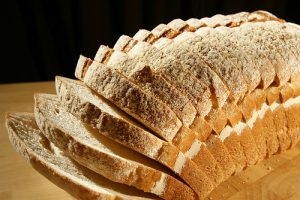
Otto Frederick Rohwedder of Davenport, Iowa, United States (pictured below, courtesy of The Woodstock Whisperer), graduated from what is now the Northern Illinois College of Ophthalmology and Otology in Chicago in 1900, with a degree in optics. He went to work as a jeweler, but used his skills to invent new devices. Convinced that he could build a machine that could slice a loaf of bread into individual, even pieces, he sold his three jewelry stores to afford the supplies. Unfortunately, a fire in the factory where he worked destroyed not only his prototype, but the blueprints, as well.
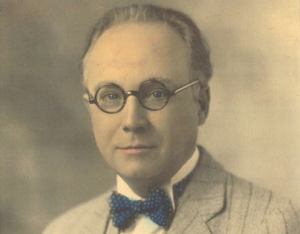
It would take Rohwedder several years to secure the funds needed to build again, but by 1927, he had crafted and tested a machine that not only sliced bread, but wrapped it, as well. After applying for patents, he sold his first machine to a baker-friend named Frank Bench, who installed it at the Chillicothe Baking Company, in Chillicothe, Missouri, in 1928. The first loaf of sliced bread was sold commercially on July 7, 1928.
In advertising their shiny new sliced bread, the Chillicothe Baking Company stated in their advertising that it was “the greatest forward step in the baking industry since bread was wrapped”. In 1940, a form of bread consisting of two wrapped half-loaves, called Southern Slice Bread, was advertised as the “greatest convenience since sliced bread”…sound familiar? A few after Chillicothe made history, Wonder Bread made sliced bread a nation-wide product, which in turn, boosted the sale of single-slice toasters. So when you’re having your breakfast, or sandwich, or afternoon tea today, feel free to regale your friends and eating companions with today’s fact of the day, dear readers. I’m sure they’ll all be very grateful.
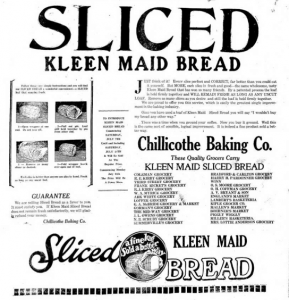
Hey, and speaking of that, you know what else is the best thing since sliced bread? New book! Here are some of the titles that have dashed up onto our shelves this week, and are eagerly waiting to join you in your summer excursions!

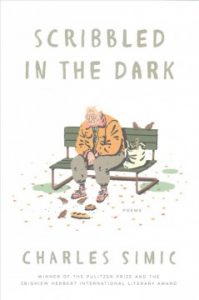 Scribbled in the Dark: Anyone looking to overcome their metrophobia should look no further than friend of the Peabody Library, Charles Simic’s newest book. In each of these pieces, all of which are single-serving portions of poetry, Simic manages to combine the mundane, the familiar, and the cosmic and overwhelming, creating poetry that is at once accessible and eye-opening. Peopled by policemen, presidents, kids in Halloween masks, a fortune-teller, a fly on the wall of the poet’s kitchen, from crowded New York streets, to park benches, these works toy with the end of the world and its infinity, with its ugliness and its beauty. Charles Simic continues to be an imitable voice in modern American poetry, one of its finest chroniclers of the human condition. Publisher’s Weekly gave this collection a starred review, relishing that “Image by image, Simic composes miniature masterpieces, offering what appears as a seemingly effortless study in language’s cinematic possibilities.”
Scribbled in the Dark: Anyone looking to overcome their metrophobia should look no further than friend of the Peabody Library, Charles Simic’s newest book. In each of these pieces, all of which are single-serving portions of poetry, Simic manages to combine the mundane, the familiar, and the cosmic and overwhelming, creating poetry that is at once accessible and eye-opening. Peopled by policemen, presidents, kids in Halloween masks, a fortune-teller, a fly on the wall of the poet’s kitchen, from crowded New York streets, to park benches, these works toy with the end of the world and its infinity, with its ugliness and its beauty. Charles Simic continues to be an imitable voice in modern American poetry, one of its finest chroniclers of the human condition. Publisher’s Weekly gave this collection a starred review, relishing that “Image by image, Simic composes miniature masterpieces, offering what appears as a seemingly effortless study in language’s cinematic possibilities.”
 Kingdoms of Olive and Ash: Writers Confront Occupation: This collection of essays was compiled to observe the fifty-year anniversary of the Israeli occupation of the West Bank and Gaza, organized by renowned writers Michael Chabon and Ayelet Waldman, along with the Israeli NGO Breaking the Silence—an organization comprised of former Israeli soldiers who served in the occupied territories and saw firsthand the injustice there. Each of the essays here, from writers as famous and diverse as Colum McCann, Jacqueline Woodson, Colm Toibin, Hari Kunzru, Raja Shehadeh, Mario Vargas Llosa and Assaf Gavron, goes beyond the headlines and click-bait pieces to understand what occupation means, and the cost it takes on all those involved. Booklist gave this work a starred review, noting especially its “Dramatic testimonies… radiant with telling details, vital portraits, and explosive facts…. This sensitive, galvanizing, and landmark gathering brings the occupation into sharp focus as a tragedy of fear and tyranny, a monumental failure of compassion and justice, a horrific obstacle to world peace.”
Kingdoms of Olive and Ash: Writers Confront Occupation: This collection of essays was compiled to observe the fifty-year anniversary of the Israeli occupation of the West Bank and Gaza, organized by renowned writers Michael Chabon and Ayelet Waldman, along with the Israeli NGO Breaking the Silence—an organization comprised of former Israeli soldiers who served in the occupied territories and saw firsthand the injustice there. Each of the essays here, from writers as famous and diverse as Colum McCann, Jacqueline Woodson, Colm Toibin, Hari Kunzru, Raja Shehadeh, Mario Vargas Llosa and Assaf Gavron, goes beyond the headlines and click-bait pieces to understand what occupation means, and the cost it takes on all those involved. Booklist gave this work a starred review, noting especially its “Dramatic testimonies… radiant with telling details, vital portraits, and explosive facts…. This sensitive, galvanizing, and landmark gathering brings the occupation into sharp focus as a tragedy of fear and tyranny, a monumental failure of compassion and justice, a horrific obstacle to world peace.”
 White Fur: Jardine Libaire’s novel is set in the mid-1980’s, a time of big hair and spandex, cultural clashes and divides, and all that neon intensity is reflected in the wild love story at its center. Although Elise Perez and Jamey Hyde are next-door neighbors in New Haven, they come from different worlds. Elise grew up in public housing without a father and didn’t graduate from high school. Jamey is a junior at Yale, heir to a private investment bank fortune. But when they first meet, nothing else matters. They move to Manhattan, eager to start a new life together, exploring Newport mansions and East Village dives, WASP-establishment yacht clubs and the grimy streets below Canal Street, all while fighting to stay together in a world designed to keep them apart. Like so many books out current, Libaire’s story is as much a love story to the 1980’s as it is about her characters, and her passion for place shines through every page of her book. NPR agreed, calling this book “A fairy tale of love and class and money and death and New York City in the 1980’s, as seen through eyes so new and so young that everything seems like magic all the time…What holds it together is ferocity — Libaire’s elegant, incongruous, glitz-and-trash command of the language of youth and young love, and the uncompromising fire of her main characters as they drift and dash from page to page.”
White Fur: Jardine Libaire’s novel is set in the mid-1980’s, a time of big hair and spandex, cultural clashes and divides, and all that neon intensity is reflected in the wild love story at its center. Although Elise Perez and Jamey Hyde are next-door neighbors in New Haven, they come from different worlds. Elise grew up in public housing without a father and didn’t graduate from high school. Jamey is a junior at Yale, heir to a private investment bank fortune. But when they first meet, nothing else matters. They move to Manhattan, eager to start a new life together, exploring Newport mansions and East Village dives, WASP-establishment yacht clubs and the grimy streets below Canal Street, all while fighting to stay together in a world designed to keep them apart. Like so many books out current, Libaire’s story is as much a love story to the 1980’s as it is about her characters, and her passion for place shines through every page of her book. NPR agreed, calling this book “A fairy tale of love and class and money and death and New York City in the 1980’s, as seen through eyes so new and so young that everything seems like magic all the time…What holds it together is ferocity — Libaire’s elegant, incongruous, glitz-and-trash command of the language of youth and young love, and the uncompromising fire of her main characters as they drift and dash from page to page.”
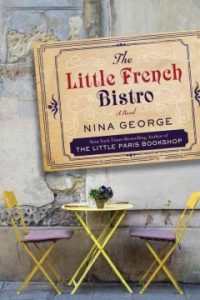 The Little French Bistro: Readers who loved George’s The Little Paris Bookshop will be delighted to return with her to France’s idyllic scenery for another tale of self-discovery and delicious food. Marianne is stuck in a loveless, unhappy marriage. After forty-one years, she has reached her limit, and one evening in Paris she decides to take action. Following a dramatic moment on the banks of the Seine, Marianne leaves her life behind and sets out for the coast of Brittany, where she meets a cast of colorful and unforgettable locals who surprise her with their warm welcome and joy for living. Gradually, as she begins to remember the parts of herself she thought long gone, Marianne learns it’s never too late to begin the search for what life should have been all along. This is another book that will seduce you with settings (and food. Seriously, the food.), as well as the rich personalities that grace these pages. Kirkus Reviews, specifically noted that it “is as much about indulging the senses with succulent dishes and dazzling sights as it is about romance and second chances. With a profound sense of place and sensuous prose, the novel functions as a satisfying virtual visit to the French Riviera. A luscious and uplifting tale of personal redemption…”
The Little French Bistro: Readers who loved George’s The Little Paris Bookshop will be delighted to return with her to France’s idyllic scenery for another tale of self-discovery and delicious food. Marianne is stuck in a loveless, unhappy marriage. After forty-one years, she has reached her limit, and one evening in Paris she decides to take action. Following a dramatic moment on the banks of the Seine, Marianne leaves her life behind and sets out for the coast of Brittany, where she meets a cast of colorful and unforgettable locals who surprise her with their warm welcome and joy for living. Gradually, as she begins to remember the parts of herself she thought long gone, Marianne learns it’s never too late to begin the search for what life should have been all along. This is another book that will seduce you with settings (and food. Seriously, the food.), as well as the rich personalities that grace these pages. Kirkus Reviews, specifically noted that it “is as much about indulging the senses with succulent dishes and dazzling sights as it is about romance and second chances. With a profound sense of place and sensuous prose, the novel functions as a satisfying virtual visit to the French Riviera. A luscious and uplifting tale of personal redemption…”
 The Best Land Under Heaven The Donner Party in the Age of Manifest Destiny: Many of us have heard of the Donner Party, that ill-fated group of travelers who got caught in the Rocky Mountains during a hellish winter…but in this new study, Michael Wallis cuts through the myths and legends that have sprung up around their story to explore who and what the Donner Party actually were, and the historical context of their journey, showing them as a microcosm of the United States at the time. There’s a great deal that still needs to be discussed about not just the Donner Party, but the concept of Manifest Destiny that drove so many people into areas that were utterly unknown to them, and the unspeakable toll those journeys took on so many lives. But Wallis has begun that process here in a book that is both empathetic and focused. The Boston Globe loved this book, noting in the review, “The saga of the Donner Party is one of the most horrific and fascinating events in the history of the American West. A cautionary tale at the time, it becomes in Michael Wallis’s thorough and persuasive new telling…of the more shadowy aspects of Manifest Destiny. . . . [A] welcome update of a nightmarish tale.”
The Best Land Under Heaven The Donner Party in the Age of Manifest Destiny: Many of us have heard of the Donner Party, that ill-fated group of travelers who got caught in the Rocky Mountains during a hellish winter…but in this new study, Michael Wallis cuts through the myths and legends that have sprung up around their story to explore who and what the Donner Party actually were, and the historical context of their journey, showing them as a microcosm of the United States at the time. There’s a great deal that still needs to be discussed about not just the Donner Party, but the concept of Manifest Destiny that drove so many people into areas that were utterly unknown to them, and the unspeakable toll those journeys took on so many lives. But Wallis has begun that process here in a book that is both empathetic and focused. The Boston Globe loved this book, noting in the review, “The saga of the Donner Party is one of the most horrific and fascinating events in the history of the American West. A cautionary tale at the time, it becomes in Michael Wallis’s thorough and persuasive new telling…of the more shadowy aspects of Manifest Destiny. . . . [A] welcome update of a nightmarish tale.”
Until next week, beloved patrons–happy reading!
